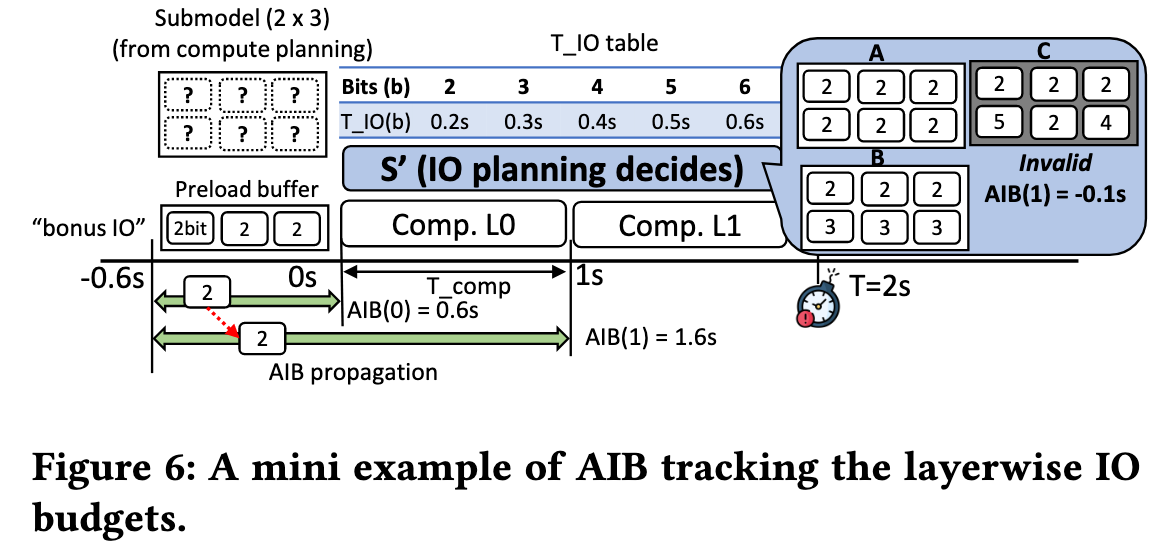Intensive Reading
Author Info
- Homepage - Liwei Guo / Assistant Professor: a tenure-track Assistant Professor at University of UESTC.
Background
Challenges
- Cold start of NLP models in mobile devices
- NLP inference stresses mobile devices on two aspects
- Latency: impromptu user engagements
- Model Size
Existing Paradigms:
- Hold in memory
- Too large memory footprint, likely to be victims of mobile memory management
- Load before execute
- Slow start, waiting for I/O, computation resources stall
- Pipeline load/execution
- Low arithmetic intensity in Transformer’s attention modules
- The pipeline is filled with bubbles and the computation stalls most of the time at each model layer
Insights
A model can be re-engineered from a monolithic block into a collection of resource-elastic “shards” by uniquely combining vertical partitioning with fine-grained, per-shard quantization. This transforms the I/O time of each model component into a tunable parameter.
A stall-free, optimal pipeline is achievable through a two-stage planner that uses an “Accumulated IO Budget” (AIB) to manage time resources. This allows the system to intelligently spend its limited I/O budget on loading higher-fidelity versions of the most accuracy-critical shards, thereby maximizing performance under strict latency constraints.
Approaches
Elastic Model Sharding
为了让模型能够灵活适应不同的资源约束,STI 首先对预训练好的模型进行预处理,将其分解为大量可供运行时选择组合的“分片”(Shards)。这个过程分两步:
- Step 1: 垂直分区
- 将 Transformer 的每一层(N层)沿着宽度方向,切分为 M 个垂直切片(vertical slices),每个切片包含一个独立的注意力头以及对应比例的 FFN 神经元
- Step 2: 分片量化
- 针对每一个 sharding,STI 会为其生成 K 个不同量化的版本
- 采用高斯离群点感知量化方法, 将绝大多数遵循高斯分布的权重用 k-bit 索引指向一个小的“质心”字典来表示,而保留极少数重要的离群点权重为 32-bit 浮点数
由于注意力头的独立性,任意数量的切片组合在一起都能执行并产生有意义的推理结果,这为动态调整模型的“宽度”提供了基础
在大模型中仍然适用吗?
通过以上两步,一个N层的模型被预处理成了磁盘上的 N x M x K 个分片版本,为运行时的弹性规划提供了丰富的选择空间。
Pipeline Planning
这部分主要是通过一定的定量分析给出了一个数学建模,然后在此基础上来确定计划的构建,分为两步
- 根据 Client 给出的总时间预算 T, STI 确定需要计算的 submodule 大小(n x m),目标是 n x m 的计算量越大越好(接近上限)
- 根据 n x m,STI 再去算对应的 AIB, 然后确定每个 shard 使用什么量化(根据量化重要程度排序),目标是 让 AIB >0 的同时精度也更高
- 确定量化时使用了一个 two-pass 的分配策略
- First Pass: 首先为所有需要动态加载的分片选择一个统一的、在不违反AIB约束下的最高基础位宽
- Second Pass: 然后利用剩余的AIB预算,根据分片重要性排名,贪婪地、迭代地将最重要的分片升级到更高的位宽(最高可达32-bit),直到所有AIB预算被耗尽
- 分片重要性:如果一个分片在被赋予更高保真度(位宽)时,能比其他分片更显著地提升模型整体的准确率,那么它就被认为更重要
- 量化容忍度:如果一个分片在被赋予更低保真度(位宽)时,其对模型整体准确率造成的负面影响比其他分片更小,那么它的量化容忍度就被认为更高
- Low tolerance => Higher bandwidth
- High tolerance => Lower bandwidth
这个策略依据的前提是:
- 无论是什么 Bit 量化(K 值怎么变),T_comp 时间基本不变,这是计算规划可以独立进行的基础
- K 变化只会影响 I/O 时间
AIB: Accumulated IO Budgets
核心思想:
流水线不会停顿的充要条件是:在执行第 k 层的计算之前,从第 0 层到第 k 层的所有分片都必须已经被加载到内存中 。基于这一点,AIB 被设计为一个记录“可用 IO 时间余额”的账本。在计算前面层的时候,IO 设备是空闲的,这段计算时间就可以被“存入” AIB,作为加载后续层数据的“预算”。
$AIB(k) = AIB(k-1)+T_{comp}(k-1)$
- $AIB(k-1)$: 上一层累积下来的 IO 预算
- $T_{comp}(k-1)$: 计算第 k-1 层所需的时间
只要所有层的 AIB 值都 大于等于零,就意味着在任何一层开始计算之前,它所需要的数据都能及时加载完毕,流水线不会停顿,因此该规划方案被视为有效
以图 6 举个例子:
- 计算规划阶段已经完成,确定了要运行一个 2层 x 3分片 的子模型
- 总任务耗时不能超过 T = 2s, T_comp = 1s
- L0 预加载了第 0 层的 3 个分片,都是 2-bit 版本
- AIB(1)=1.6s: 在第1层(L1)的计算开始之前(即在 t=1s 这个时间点),我们总共有 1.6 秒的时间可以用来加载所有需要的数据
- 留给 L1 的预算是 1.0s

Evaluation
Thoughts
When Reading
能否针对 one-shot 和 interactive 场景做不同优化?
“Sparsity is all you need”:
- Attention heads can be predicted
- Experts in MoE can be predicted
- FFN block which passes the gate can be predicted
Predict-and-prefetch is all you need
不适合目前的大模型:
- 存储开销:每个 shard 要存 {2,3,4,5,6,32} 共 6 个版本,虽然作者称只需 ~215MB 额外存储 (Sec.7.2),但对于大模型(>10B 参数)存储成本将线性放大
- Profiling 的开销也会爆炸